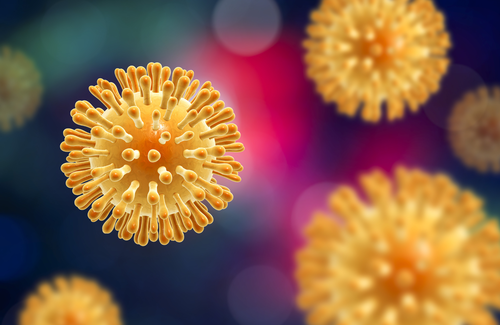
An Argentinian woman, now in her 50s, has controlled HIV below the limits of detection since stopping HIV treatment due to side effects in 2007, researchers from Buenos Aires and the US National Institutes of Health report.
The woman no longer has antibodies to HIV and researchers found only a small number of cells containing HIV DNA when they carried out intensive tests in 2015 and 2017. The researchers do not say that the woman has been cured, but say that even among people who have controlled HIV after stopping HIV treatment, this case is unique.
Partial details of this case of HIV remission were presented at a symposium in 2017 and fuller details have now been published in the journal Open Forum Infectious Diseases.
The Buenos Aires woman was diagnosed with HIV in 1996, at the age of 37, after being admitted to hospital after five weeks of blurred vision, left-sided weakness, weight loss and fever. She tested positive for toxoplasmosis as well as HIV, was treated for toxoplasmosis, started an antiretroviral regimen of zidovudine, didanosine and nevirapine and was subsequently discharged from hospital.
From 1998, she had a viral load below 50 copies, except for a small blip in 2001. She changed treatment several times due to adherence difficulties and fat loss.
The woman stopped HIV treatment due to worsening lipodystrophy in 2007. She had an undetectable viral load when she stopped treatment and has experienced no viral rebound since then. Her last undetectable viral load measurement was reported in February 2020. Her CD4 cell count has remained stable above 500 cells.
In 2013, doctors decided to investigate further, after two negative antibody tests and a negative HIV DNA suggested that HIV was not only undetectable but may have been cleared.
In 2015, and again in 2017, the woman visited the US National Institutes of Health near Washington DC to undergo clinical investigations. Researchers carried out blood tests and sampled lymphoid tissue from the gut and other lymph nodes, as well as cerebrospinal fluid. They compared their findings with samples from an HIV-negative control group and people with chronic HIV infection.
They found:
- HIV RNA (viral load) in plasma was below 0.2 copies/ml (the limit of detection on the most sensitive test available) and HIV RNA was not detectable in any lymphoid tissue samples. In people with chronic infection or long-term non-progressors, HIV would be detectable.
- No HIV DNA was detectable in colon tissue or blood mononuclear cells, but HIV DNA was detected at a very low level in lymph node tissue.
- Replication-competent HIV was detected at a “profoundly small” level in CD4 T-cells.
- No antibodies to HIV could be detected.
- HIV-specific CD8+ T-cell responses that would indicate the presence of HIV were feeble but HIV-specific CD4+ responses were higher than in HIV-negative controls.
To confirm that her HIV diagnosis in 1996 had not been a false-positive diagnosis, the researchers also looked at a stored sample of brain tissue obtained by biopsy in 1996 to help diagnose the woman’s neurological condition. This sample contained HIV DNA, although no HIV RNA, and confirms that the woman did have HIV infection in 1996. Furthermore, the pattern of brain white-matter shown in MRI scans was consistent with a history of HIV encephalopathy (HIV-related dementia). Physical examinations showed no evidence of dementia and the woman remained in full-time work as a seamstress.
The researchers say that this case is “extremely unique”. As well as being one of the longest examples of post-treatment HIV control fully documented, the loss of antibodies (seroreversion) is highly unusual. The Berlin patient – one of two people cured of HIV after bone marrow transplants – retained HIV antibodies after cure. The researchers say that loss of antibodies is probably a consequence of a prolonged period living with “remarkably low” levels of HIV antigen.
The very weak HIV-specific CD8 cell responses – so-called 'killer T-cells' which clear virus-infected cells – are also highly unusual in a spontaneous or post-treatment controller of HIV, say the researchers.
The existence of post-treatment controllers was first announced in 2013, when French researchers reported on the VISCONTI cohort.
Dr Asier Saez-Cirion, VISCONTI's principal investigator, told aidsmap.com: "Each post-treatment controller is unique. This Buenos Aires case is interesting because of the very complete clinical, immunological and virological evaluation.
"We have so far identified 27 post-treatment controllers in the VISCONTI study. The median time off ART is now 10.5 years and we have a few cases who have maintained post-treatment remission for over 20 years. We also observed different degrees of loss of antibodies to HIV in some.
"We can learn a lot from these cases. I think they offer hope that remission can be achieved, even when starting from a quite negative clinical context."
For their part, the Buenos Aires researchers conclude: “This case might represent the best example of posttreatment functional cure and... offers hope that durable remission without the need for excessively toxic interventions.”
But despite their optimistic conclusion, they are at a loss to explain how HIV has been controlled since the Argentinian woman stopped treatment in 2007.
Uruena A et al. Prolonged posttreatment virologic control and complete seroreversion after advanced human immunodeficiency virus-1 infection. Open Forum Infectious Diseases 8: ofaa613, 2021 (open access).

